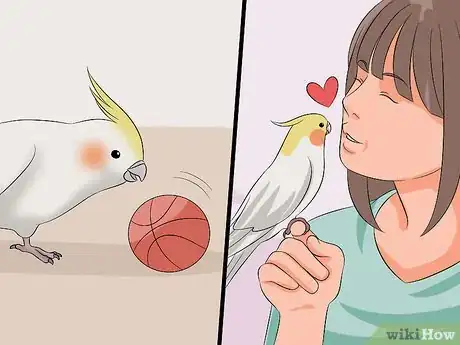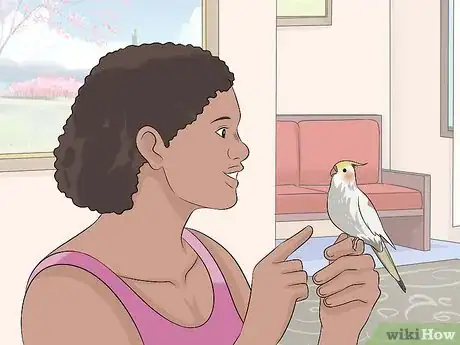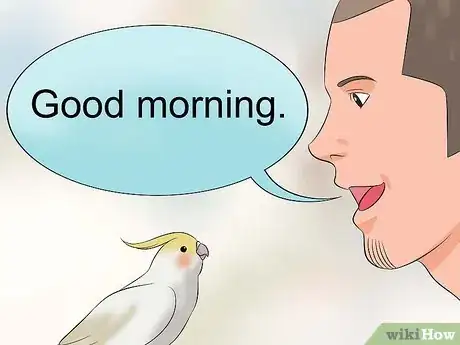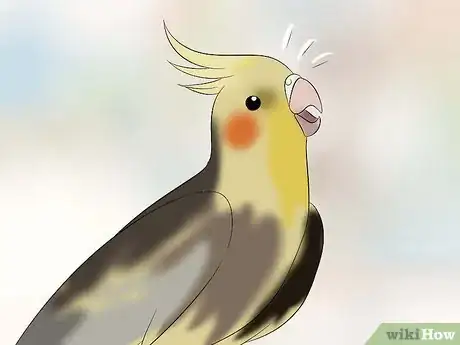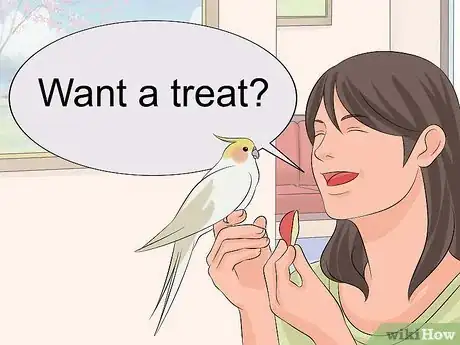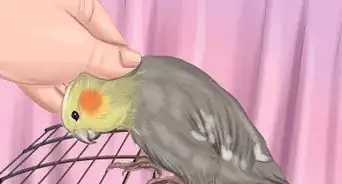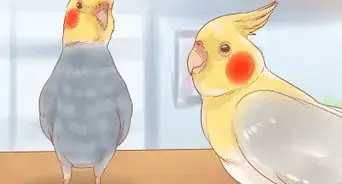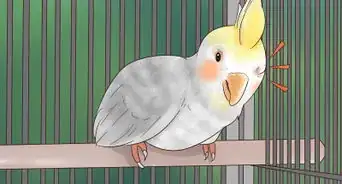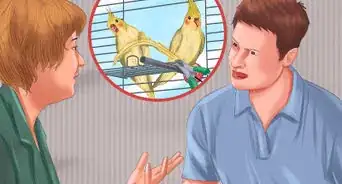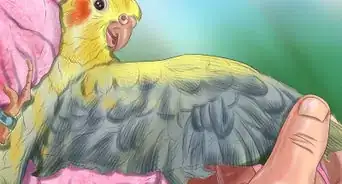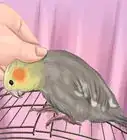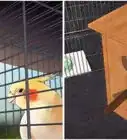This article was co-authored by Pippa Elliott, MRCVS. Dr. Elliott, BVMS, MRCVS is a veterinarian with over 30 years of experience in veterinary surgery and companion animal practice. She graduated from the University of Glasgow in 1987 with a degree in veterinary medicine and surgery. She has worked at the same animal clinic in her hometown for over 20 years.
wikiHow marks an article as reader-approved once it receives enough positive feedback. This article received 22 testimonials and 88% of readers who voted found it helpful, earning it our reader-approved status.
This article has been viewed 296,799 times.
Cockatiels can make great pets and teaching them to talk can be a great way for you and your pet to bond. A talking cockatiel repeats syllables, making a robotic replication of words or noises you say to it. Your cockatiel's speech will never sound as clear as that of a parrot, but with some work you should be able to understand the words it says to you. In order to get your cockatiel to talk to you, you must first teach it to talk and then work with the bird to reinforce and expand its vocabulary.
Steps
Making Your Cockatiel Comfortable
-
1Bond with the bird first. Human interaction is key to teaching a cockatiel to talk. While some people believe you can teach a bird to talk and tame it at the same time, this is a false belief. Instead, you need to bond with the bird and get it used to its home before talking training.
- If you need some help taming a bird, your local veterinarian or pet store owner can help you, or an experienced friend can too.
-
2Make sure your cockatiel is healthy. Make sure your bird has enough food and water, as well as enough space in its cage. Also make sure that your bird is in good physical health by taking it for veterinary checkups on a regular basis. If your cockatiel is feeling under the weather, it is less likely to want to chat with you.Advertisement
-
3Make sure your cockatiel is happy. Give it lots of attention and mental stimulation. Teaching the cockatiel to talk is part of that attention, but you also want to give it toys to play with and praise and affection whether it is talking or not. A cockatiel's brain needs to be stimulated in order for it to be happy.
- Also make sure that the bird is in an environment that it likes. That way the bird will feel more comfortable when learning words.
Teaching Your Cockatiel to Repeat Words
-
1Train the bird in a quiet place. This will allow your bird to focus on you and your words. If your bird is easily distracted you can even try talking to it while its cage is covered. This will eliminate visual distractions as well.[1]
-
2Introduce the bird to one phrase at a time. Keep it easy and short and use one that you say frequently, for instance the bird's name.[2] If you want to teach it something other than its name, remember that the phrase should be simple, containing one or two words that are relatively high pitched.
- Since cockatiels have high pitches voices, you may not be able to teach it words that you say in a low tone.
- Use the words at the right time, such as don't teach it "Good morning" in the night when you are about to sleep, and vice versa.
-
3Focus on words that your bird "likes." Look at the cockatiel's eyes. Are its pupils getting larger when you say a certain word? Does the bird's crest go up to indicate excitement or interest? If you see neither, you may not be teaching the bird a word it likes saying.
- The cockatiel may not be repeating your phrase for other reasons too. For instance, it may be that the bird is not physically able to say it.
-
4Strengthen the behavior with positive reinforcement. Give the bird lots of treats and attention whenever the bird says a word correctly. Depending on your birds preferences, there isn't really a "right" thing to do. Some birds may like human food better, but some may like special bird treats. What ever you do, make it positive.[3]
-
5Repeat the phrase often and be patient. No matter how smart your birdie is, it will not be Einstein. You must be patient, otherwise your bird will become frightened of you and you will have lost all the progress you have achieved. One single hand movement can do this, so be careful
-
6Complicate and increase the phrases you teach the cockatiel. Once your bird has one phrase down, give it more to learn. After all, you don't want to hear just one phrase from your bird all day.
- Try narrating things you do for your cockatiel. When you feed it an apple, say "want a treat?" If you do this enough, and your bird likes talking, it may start saying the phrase when it sees the treat coming.
- Try whistling at your cockatiel. If you give it a simple series of notes repeatedly, it just might repeat it back to you. Be warned, however, that once a cockatiel learns how to whistle, it may choose whistling over talking. This is because whistling is easier for the bird.[4]
Warnings
- Don't get frustrated. Each bird is different and will take a different amount of training before it speaks. In fact, some birds will never speak. Do your best and don't get angry with the bird, as it will not respond well to anger. Anger is likely to deter it from talking even more.⧼thumbs_response⧽
References
- ↑ https://books.google.com/books?id=ApL4ckzSdywC&pg=PA112&lpg=PA112&dq=teach+a+cockatiel+to+talk&source=bl&ots=XqFWoGyujS&sig=ijWdTanbKL2iEe8gRXp7O8oJGXc&hl=en&sa=X&ved=0CDYQ6AEwBDgeahUKEwik5eOoiaLHAhXGoogKHbrDBXE#v=onepage&q=teach%20a%20cockatiel%20to%20talk&f=false
- ↑ https://books.google.com/books?id=ApL4ckzSdywC&pg=PA112&lpg=PA112&dq=teach+a+cockatiel+to+talk&source=bl&ots=XqFWoGyujS&sig=ijWdTanbKL2iEe8gRXp7O8oJGXc&hl=en&sa=X&ved=0CDYQ6AEwBDgeahUKEwik5eOoiaLHAhXGoogKHbrDBXE#v=onepage&q=teach%20a%20cockatiel%20to%20talk&f=false
- ↑ https://books.google.com/books?id=ApL4ckzSdywC&pg=PA112&lpg=PA112&dq=teach+a+cockatiel+to+talk&source=bl&ots=XqFWoGyujS&sig=ijWdTanbKL2iEe8gRXp7O8oJGXc&hl=en&sa=X&ved=0CDYQ6AEwBDgeahUKEwik5eOoiaLHAhXGoogKHbrDBXE#v=onepage&q=teach%20a%20cockatiel%20to%20talk&f=false
- ↑ https://books.google.com/books?id=ApL4ckzSdywC&pg=PA112&lpg=PA112&dq=teach+a+cockatiel+to+talk&source=bl&ots=XqFWoGyujS&sig=ijWdTanbKL2iEe8gRXp7O8oJGXc&hl=en&sa=X&ved=0CDYQ6AEwBDgeahUKEwik5eOoiaLHAhXGoogKHbrDBXE#v=onepage&q=teach%20a%20cockatiel%20to%20talk&f=false
- ↑ https://books.google.com/books?id=ApL4ckzSdywC&pg=PA112&lpg=PA112&dq=teach+a+cockatiel+to+talk&source=bl&ots=XqFWoGyujS&sig=ijWdTanbKL2iEe8gRXp7O8oJGXc&hl=en&sa=X&ved=0CDYQ6AEwBDgeahUKEwik5eOoiaLHAhXGoogKHbrDBXE#v=onepage&q=teach%20a%20cockatiel%20to%20talk&f=false
About This Article
To train a cockatiel to talk, start by bonding with your bird by giving it lots of attention and affection so that it feels comfortable with you. Next, find a quiet place without distractions and introduce one simple phrase, such as the bird’s name, in a high pitched voice. Then, repeat the phrase often and don’t lose your patience by yelling or making sudden movements to avoid scaring your bird. Once the bird says the phrase correctly, give it lots of treats to encourage the behavior with positive reinforcement. For more tips, like how to tell if your bird likes the phrase you’re trying to teach, read on!


